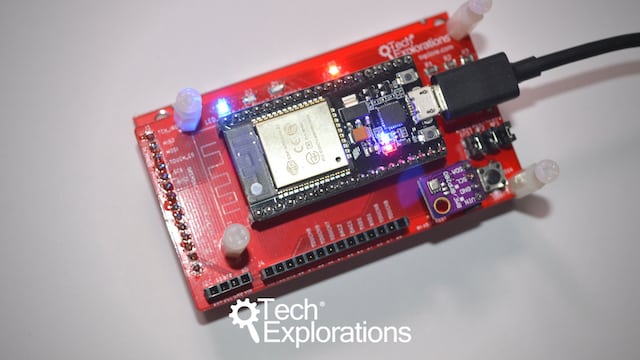In the week since my last update, I have made several modifications and additions to my project.
Here’s what my ESP32 gadget contains:
- A ESP32 WROOM-32 Dev Kit v4
- A BME280 I2C sensor
- A 2.8″ TFT SPI display, 240×320, with touch interface (ILI9341 controller)
- Two LEDs and their resistors
Here’s what this gadget can do:
-
Environment sensing
- Every 30 seconds:
- it will take a reading from the sensors and transmit them to adafruit IO via MQTT
- it will update the TFT with these readings
- it will update a transmit counter in the EEPROM (so I can keep track of how many updates succeeded since the last restart)
- This information is available as a custom Dashboard on io.adafruit.com (I’ve made this public, check it out!).
- Every 30 seconds:
-
Clock
- It will get the time/date from a time server
- It will adjust the time/date for my time zone
- It will update the time/date on the TFT display once per second
- It will keep a reasonably accurate time even without connection to the Internet
-
Voice control with Google Assistant and IFTTT
- I can say “Ok Google, turn on LED” or “Ok Google, turn off LED” to my Google Home Mini (this works with any Google Assistant device or app)
- The instruction is picked up by Google Assistant, relayed to IFTTT.
- An app on IFTTT will parse the instruction and update my feed on adafruit.io
- Adafruit.io will push the update to my gadget and the state of the LED is changed accordingly.
-
TFT display
- Print arbitrary text
- Use existing fonts, or create your own
- Display graphics
- Create graphics
-
Touchscreen control
- I can tap on a specific section of the screen to turn on the LED
- Tapping anywhere else will turn off the LED
-
Other “features”
- On first start, the gadget will present a touchscreen calibration routine.
- Fonts and images are stored on the ESP32 integrated SPIFS (SPI file system). No need for an SD Card.
- Wifi status is displayed on the TFT.
- Available RAM (heap, in bytes) is displayed on the TFT.
- A timer watchdog will reboot the gadget if it locks up for more than 30 seconds. A lockup is determined the loop() function is not visited for that amount of time.
In making this gadget, there is so much to learn. Apart from making all these features work, and the details of the hardware, the C/C++ program, and the various cloud platforms (namely, Adafruit IO, Google Assistant and IFTTT), it is a great project for learning how to work with larger microcontrollers.
The ESP32 is great for projects that combine multiple capabilities. It has more RAM, more flash, two processing cores, Wifi and Bluetooth (I only used Wifi in this project), and even a file system. This way way beyond what an Arduino Uno can even “dream” of.
I have only scratched the surface of what is possible with this device, but I have managed to do all this using the Arduino IDE platform, and by only slightly extending my Arduino skills.
I split the sketch to multiple files to make it easier to manage.
I ran into trouble when I tested the HTTP REST API of Adafruit IO. The gadget would freeze and restart at random intervals. I suspect that the Wifi subsystem is the culprit, but have not concluded. These random reboots caused me to investigate memory leaks, the ESP32’s Wifi stack, the timer watchdog, and applying more appropriate programming methods for this project. I realise that MQTT is a far more efficient protocol, and reverted to using that. I am still investigating the issue of encryption.
I will share the code and schematics once I’m happy with the structure and features.
In the meantime, please leave your comments and thoughts below. What else would you like me to try? Do you have a theory about what might me causing the Wifi/HTTP REST reboots?
Ready for some serious learning?
Enrol to
ESP32 for Busy People
This is our comprehensive ESP32 course for Arduino Makers.
It's packed with high-quality video, mini-projects, and everything you need to learn Arduino from the ground up.
Just click on the big red button to learn more.

Ready for some serious learning?
Enrol to
ESP32 Unleashed
A new learning adventure awaits you.
Create an application that will stretch your existing knowledge and skills.
ESP32 Unleashed is a project course
This course is perfect for people familiar with the ESP32, especially graduates of ESP32 For Busy People.
It is a guided project, designed to teach you how to use modern tools to create modern embedded applications based on the ESP32.
Just click on the big red button to learn more.
